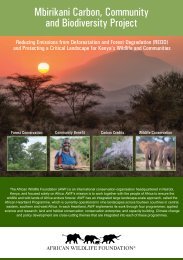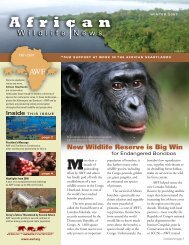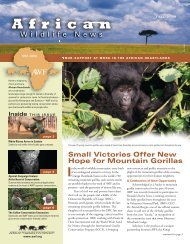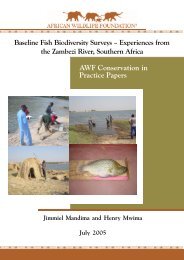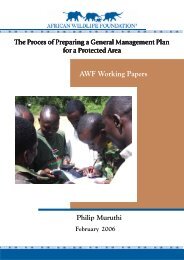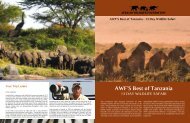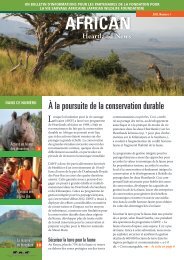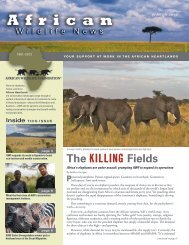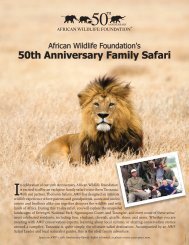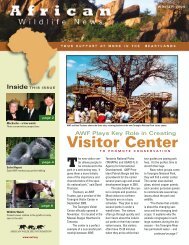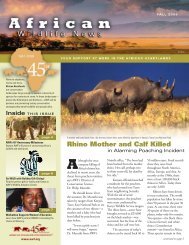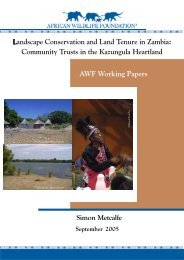Mbirikani Carbon, Community and Biodiversity Project - Reducing ...
Mbirikani Carbon, Community and Biodiversity Project - Reducing ...
Mbirikani Carbon, Community and Biodiversity Project - Reducing ...
You also want an ePaper? Increase the reach of your titles
YUMPU automatically turns print PDFs into web optimized ePapers that Google loves.
<strong>Mbirikani</strong> <strong>Carbon</strong>, <strong>Community</strong><br />
<strong>and</strong> <strong>Biodiversity</strong> <strong>Project</strong><br />
<strong>Reducing</strong> Emissions from Deforestation <strong>and</strong> Forest Degradation (REDD)<br />
<strong>and</strong> Protecting a Critical L<strong>and</strong>scape for Kenya’s Wildlife <strong>and</strong> Communities<br />
Forest Conservation <strong>Community</strong> Benefit <strong>Carbon</strong> Credits Wildlife Conservation<br />
The African Wildlife Foundation (AWF) is an international conservation organisation headquartered in Nairobi,<br />
Kenya, <strong>and</strong> focused solely on Africa. AWF’s mission is to work together with the people of Africa to ensure the<br />
wildlife <strong>and</strong> wild l<strong>and</strong>s of Africa endure forever. AWF has an integrated large l<strong>and</strong>scape-scale approach, called the<br />
African Heartl<strong>and</strong> Programme, which is currently operational in nine l<strong>and</strong>scapes across fourteen countries in central,<br />
eastern, southern <strong>and</strong> west Africa. In each Heartl<strong>and</strong>, AWF implements its work through four programmes: applied<br />
science <strong>and</strong> research; l<strong>and</strong> <strong>and</strong> habitat conservation; conservation enterprise; <strong>and</strong> capacity building. Climate change<br />
<strong>and</strong> policy development are cross-cutting themes that are integrated into each of these programmes.
AWF AnD CLiMAtE ChAngE<br />
AWF recognises the threat of climate change to Africa <strong>and</strong> is working to implement an<br />
integrated climate change programme to:<br />
1. Improve underst<strong>and</strong>ing of climate change through education, capacity building <strong>and</strong> training.<br />
2. Reduce carbon emissions, forest degradation <strong>and</strong> deforestation, <strong>and</strong> generate community <strong>and</strong><br />
conservation income through carbon offset programmes.<br />
3. Mitigate the impacts of climate change through large-scale conservation.<br />
4. Improve monitoring, scientific assessment <strong>and</strong> modeling of climate change.<br />
5. Help communities adapt to the impacts of climate change.<br />
Niger R.<br />
Regional Parc W<br />
Congo<br />
Kazungula<br />
thE KiLiMAnjARo hEARtLAnD<br />
Kilimanjaro Heartl<strong>and</strong> stretches from Amboseli<br />
National Park, to the Chyulu Hills <strong>and</strong><br />
Tsavo West National Parks in Kenya, to Mt.<br />
Kilimanjaro National Park in Tanzania. Amboseli<br />
National Park, 392 km 2 , forms the core of the<br />
ecosystem, while six surrounding community<br />
l<strong>and</strong>s, known as group ranches, surround the<br />
park. While Amboseli National Park is world<br />
renowned for its elephants <strong>and</strong> magnificent<br />
views of Mt. Kilimanjaro, the park is too small<br />
to support viable populations of elephants,<br />
predators <strong>and</strong> ungulates. Wildlife is dependent<br />
on the unprotected community l<strong>and</strong>s outside<br />
the park.<br />
Wil dlife historically have moved between<br />
Amboseli National Park <strong>and</strong> the Chyulu<br />
Mountains. This strategic linkage is critical to<br />
the viability of Amboseli’s elephant population<br />
<strong>and</strong> other mammals, including lion, cheetah,<br />
<strong>and</strong> a diversity of ungulates.. The protection<br />
of this area would successfully link three<br />
of Kenya’s most celebrated national parks:<br />
Amboseli, Chyulu <strong>and</strong> Tsavo <strong>and</strong> help to ensure<br />
the parks’ long-term viability. AWF is working<br />
with partners to maintain a wildlife linkage,<br />
while providing incentives to the surrounding<br />
communities.<br />
Orange R.<br />
Congo R.<br />
Nile R.<br />
Virunga<br />
Maasai Steppe<br />
Zambezi<br />
Zambezi R.<br />
Limpopo<br />
Samburu<br />
Kilimanjaro<br />
<strong>Mbirikani</strong> <strong>Carbon</strong>, Communi<br />
Kilimanjaro<br />
<strong>Mbirikani</strong> Group Ranch is located in Kajiado District in southern Kenya, between Amboseli,<br />
Chyulu Hills <strong>and</strong> Tsavo National Parks.
ty <strong>and</strong> <strong>Biodiversity</strong> <strong>Project</strong><br />
MBiRiKAni CARBon PRojECt, KEnyA<br />
On the east side of this wildlife linkage is <strong>Mbirikani</strong> Group Ranch.<br />
The Group Ranch is approximately 320,000 acres, bordered on<br />
the eastern edge by the Chyulu Hills National Park. <strong>Mbirikani</strong> is<br />
owned <strong>and</strong> run communally by approximately 4,500 members<br />
of Maasai pastoralists. There are just over 15,000 people living<br />
on the ranch, along with some 60,000–90,000 head of livestock.<br />
Permanent water is scarce. Rainfall is erratic <strong>and</strong> averages<br />
between 350 <strong>and</strong> 500mm per year, making it one of Kenya’s driest<br />
areas. This, in turn, makes it difficult for the community to generate<br />
income from other means besides pastoralism. Developing<br />
alternative income generating mechanisms is critical to ensuring<br />
livelihoods in this area.<br />
Less than 3% of Kenya is forested. The <strong>Mbirikani</strong> community is<br />
dependent upon the forest <strong>and</strong> the rangel<strong>and</strong>s for their livelihoods.<br />
<strong>Mbirikani</strong> contains lava, dryl<strong>and</strong> <strong>and</strong> cloud forest, which provides<br />
important refuge to wildlife, including elephant, lion, cheetah,<br />
leopard, giraffe, buffalo, impala, gazelle, hyena <strong>and</strong> jackal. Given<br />
the national <strong>and</strong> local importance of <strong>Mbirikani</strong>’s forest, AWF<br />
embarked on a regional <strong>and</strong> local carbon offset programme with<br />
the community.<br />
The <strong>Mbirikani</strong> REDD project has been designed to deliver positive<br />
climate change impacts by avoiding forest degradation <strong>and</strong><br />
deforestation, while delivering numerous other livelihood <strong>and</strong><br />
ecosystem benefits to the community.<br />
The <strong>Mbirikani</strong> REDD project has been set up to:<br />
• Protect more than 20,000 hectares of forest from further<br />
unplanned, mosaic deforestation <strong>and</strong> forest degradation.<br />
• Prevent future greenhouse gas emissions from deforestation<br />
<strong>and</strong> forest degradation.<br />
• Promote <strong>and</strong> develop systems for sustainable forest product<br />
utilisation with forest-dependent communities.<br />
• Develop alternative livelihoods with forest-dependent communities.<br />
• Build local capacity <strong>and</strong> underst<strong>and</strong>ing of REDD mechanisms.<br />
• Develop systems to facilitate replication in other locations<br />
based on the successful application of these methods.<br />
• Sell carbon credits to benefit the community <strong>and</strong> support the<br />
conservation of the forest.<br />
AWF has an MOU agreement with The Group Ranch <strong>and</strong> has<br />
completed the following:<br />
Drivers of deforestation study<br />
REDD training for the community <strong>and</strong> group ranch committee<br />
<strong>Project</strong> Idea Note (PIN)<br />
<strong>Project</strong> Development Document (PDD)<br />
Alternative livelihood assessment completed <strong>and</strong> some<br />
projects initiated<br />
The <strong>Mbirikani</strong> forest is threatened by conversion <strong>and</strong> change of use; logging for firewood, building materials <strong>and</strong> rungus (a Maasai weapon);<br />
<strong>and</strong> charcoal production. AWF is working with partners, including the <strong>Mbirikani</strong> Group Ranch <strong>and</strong> the Maasail<strong>and</strong> Preservation Trust, to<br />
mitigate the threat to the forest through alternative livelihood programmes. These include: alternative cookers (fuel-efficient jikos); improved<br />
rangel<strong>and</strong>s <strong>and</strong> income from livestock through enhanced market linkage; reforestation; tree planting; <strong>and</strong> sustainable charcoal.<br />
Lava Forest<br />
Cloud Forest<br />
Closed wood forest Open Woodl<strong>and</strong><br />
CERtiFiCAtion<br />
AWF will be seeking certification from<br />
the Voluntary <strong>Carbon</strong> St<strong>and</strong>ard (VCS)<br />
<strong>and</strong>, <strong>Community</strong> Conservation <strong>and</strong><br />
<strong>Biodiversity</strong> (CCB).<br />
The voluntary carbon market, while<br />
still under development, provides an<br />
excellent opportunity for communities<br />
to generate income to support their<br />
livelihoods <strong>and</strong> conservation efforts.<br />
In particular, communities that live in<br />
remote areas, such as the <strong>Mbirikani</strong><br />
community, lack the financial incentives<br />
to protect their l<strong>and</strong>. The ability of these<br />
communities to access carbon markets<br />
provides a potential source of revenue<br />
for forest conservation <strong>and</strong> livelihood<br />
improvement.
Photo Credits: Paul Lampert, Debby Rooney, Billy Dodson, David Williams, Tom Schosvo <strong>and</strong> AWF.<br />
AWF is seeking support for the carbon programme <strong>and</strong> a buyer for the<br />
carbon credits. For more information about carbon <strong>and</strong> alternative<br />
livelihood programmes please contact:<br />
www.maasail<strong>and</strong>preservationtrust.com<br />
Kathleen H. Fitzgerald<br />
Director, L<strong>and</strong> Conservation<br />
Nairobi, Kenya<br />
kfitzgerald@awfke.org<br />
Tel: 253 729 406222<br />
Daniel J. McGahey<br />
Programme Design Officer, Europe<br />
Oxford, Engl<strong>and</strong><br />
dmcgahey@awf.org<br />
Technical Partner: Camco<br />
Nairobi - Kenya<br />
www.awf.org



